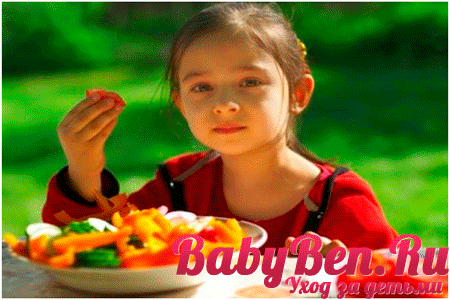
Child food for 2-3 years already in many ways is similar to that food that family members eat. To carry out normal feeding the baby at this age, the main task is the right chewing.
Thoroughly chew food with a small person help the milk teeth for two years already up to twenty. The kid must learn how to make food correctly. To organize a normal nutrition of a child for 2-3 years, it is necessary to gradually introduce more dense foods - well-strained porridge, vegetables (stewed and casseroles of them), casserole from different croup. The child's nutrition in 2-3 years should consist of breakfast, lunch, afternoon and dinner. For a day, the daughters should receive 1400-1500 kilocalories. 
Two-year-old kids diet
In the daily diet of the child in 2-3 years should be:
- protein - 50-60 g, from which 3/4 - animal origin;
- fats - 50-60 g, including 1/5 plant;
- carbohydrates - 220 g
The kid's diet in 2-3 years, of course, must contain a significant amount of ferocular products (per day):
- 25-50 g of cottage cheese 5-11% fatness;
- 5-20 g of sour cream or cream 10-20% fatness;
- 250-500 ml of milk and a high degree of fatty kefir;
- 5 g cheese.
Milk and fermented milk drinks must eat every day, and sour cream, cheese and cream can be given through day-dumped dumplings, casserole and cheesery.
Meat consumption with a small little man increases by 3 years to 120 grams daily. The meat is prepared in the form of a kitlet (for a couple or wind), stew. Use veal, low-fat pork, beef, rabbit. 
Chicken eggs include in the nutrition of a child for 2-3 years to 1/2 per day only those that are welded screwed or prepared as an omelet. Fish to children at this age give approximately 30-40 grams per day, better in the form of bouts or a boiler from low-fat river and sea grades. Unwanted fish smoked, greasy and delicious, as well as caviar.
Овощи в детском питании – хорошая профилактика запоров.Кроме того, овощи повышают аппетит. В ежедневном питании ребенка 2-3 лет должен быть картофель (100-120 граммов) и другие овощи в количестве 120-200 граммов (тыква, свекла, капуста, морковь, помидоры). В питание малыша добавляются: зелень (петрушка, салат, шпинат) в небольших количествах, а также репа, горох, фасоль, редис. Вместо пюре карапуз ест мелко порезанный салат, мелко порезанные овощи в рагу или супах.
Фрукты ребенок должен есть ежедневно, примерно 100-200 грамм (груши, бананы, яблоки, вишни без косточек). С цитрусовыми и экзотическими фруктами нужно быть очень осторожными из-за их аллергенности.
Крупы очень полезны для детского питания: в первую очередь, гречневая и овсяная. Дети могут уже есть и макаронные изделия, но переусердствовать не надо, так как эти продукты содержат много углеводов. В день малыш должен получать не более 50 грамм макаронных изделий и 15-20 граммов круп. 
Норма дневного потребления сахара — 30-40 грамм, включая сахар в напитках, сладостях и соках. Из сладостей допускаются зефир, пастила, карамель (фруктовая), мармелад. Шоколад и шоколадные конфеты малышу в этом возрасте пока давать не стоит.
